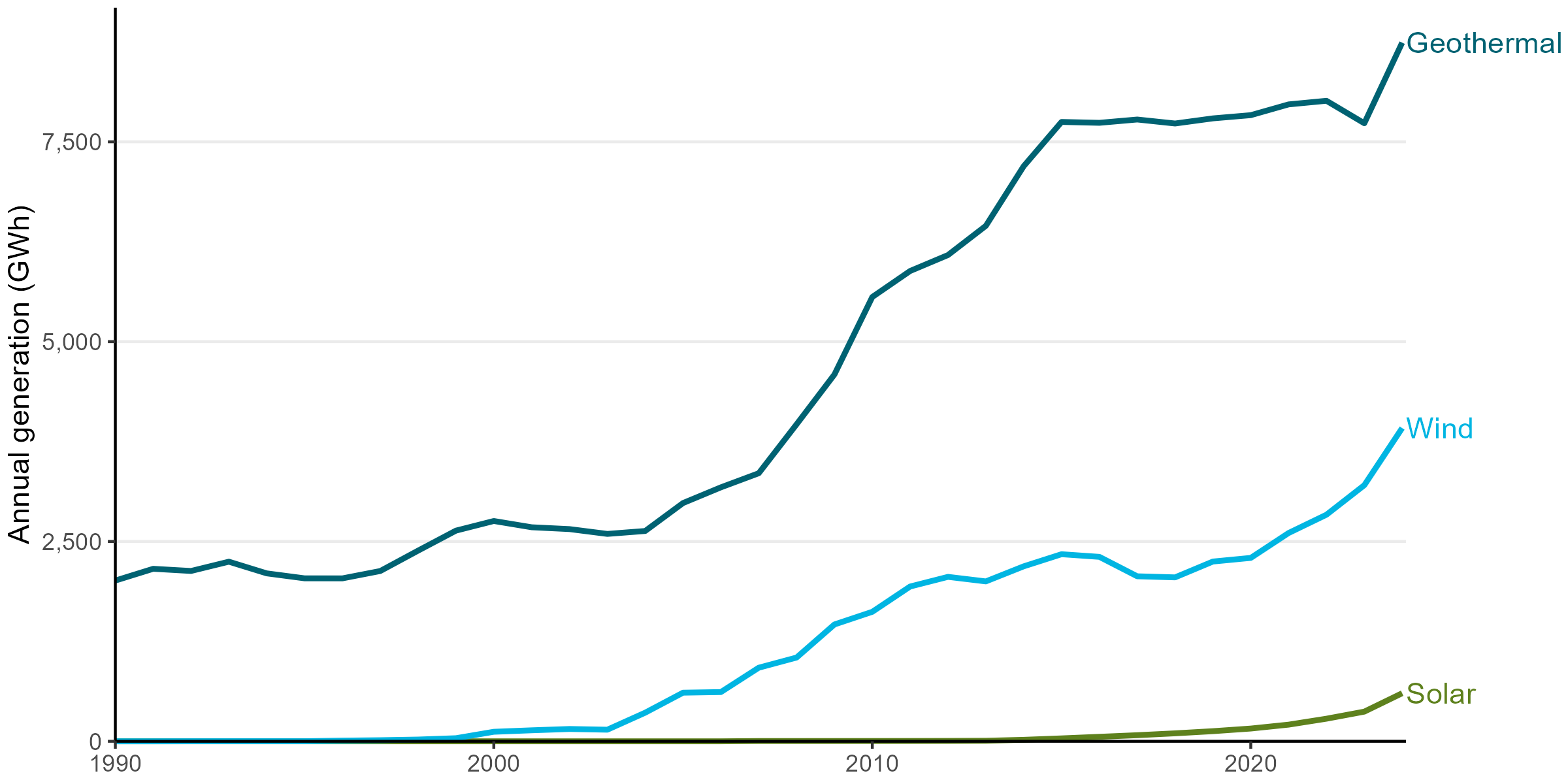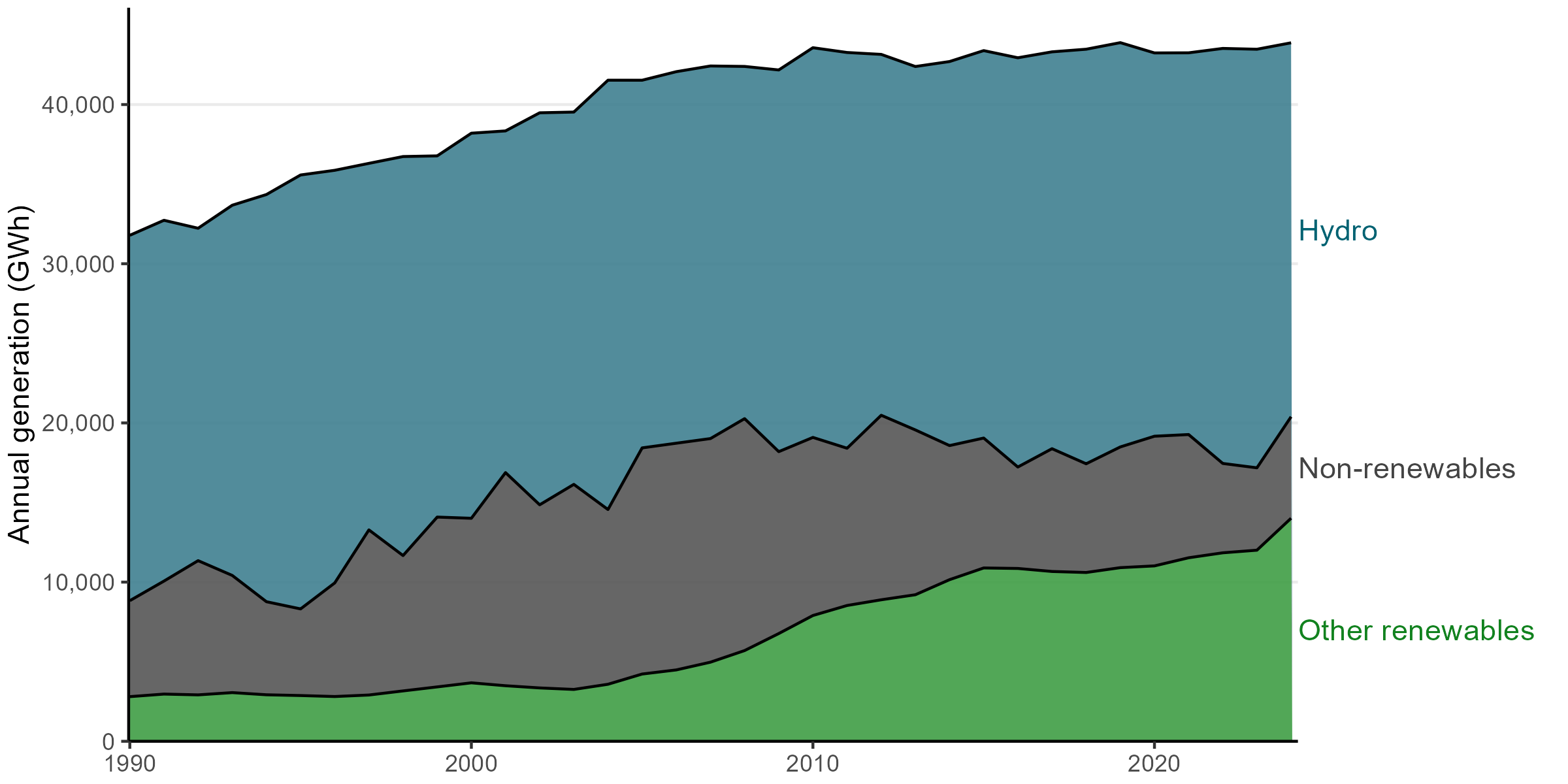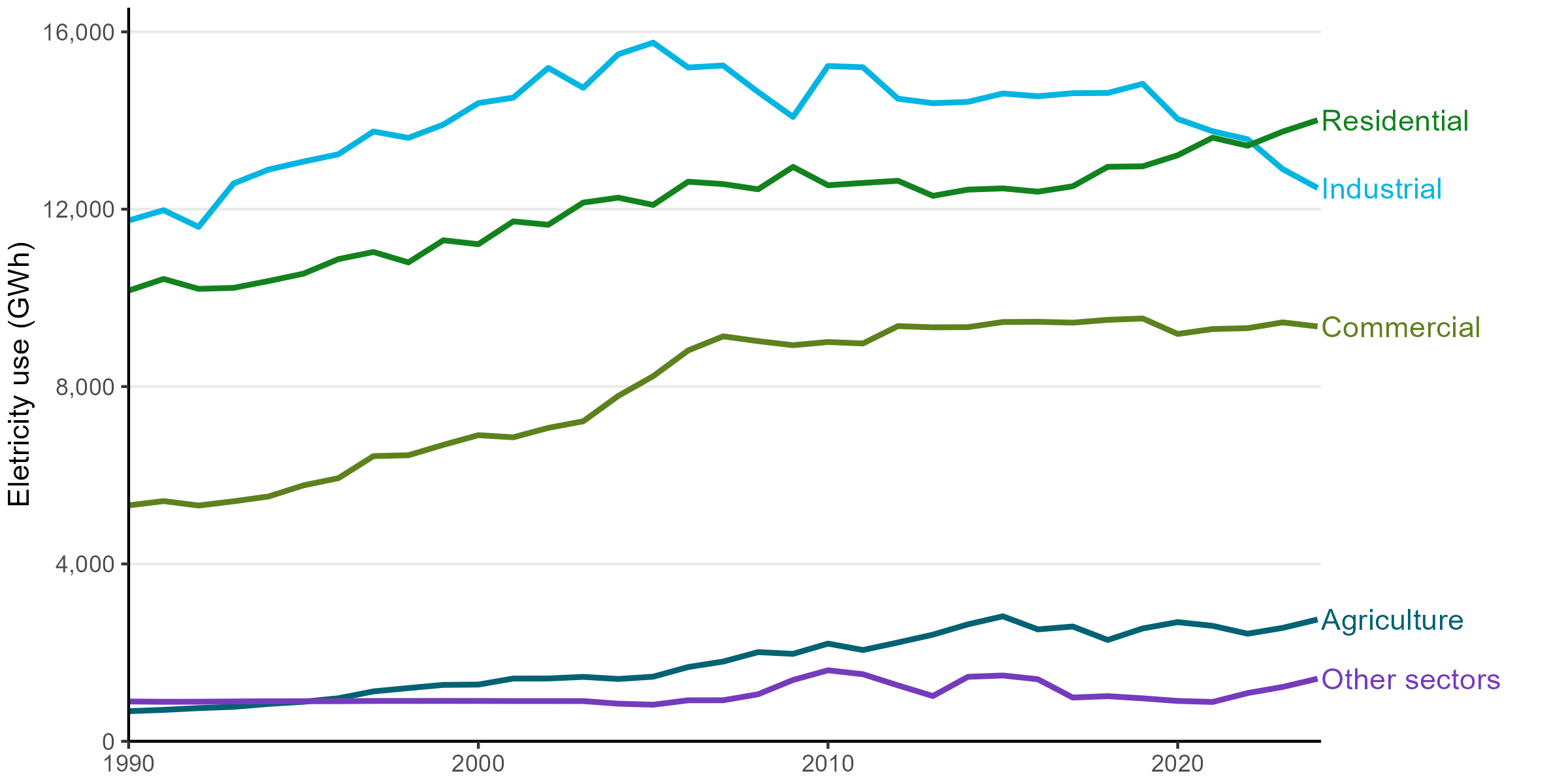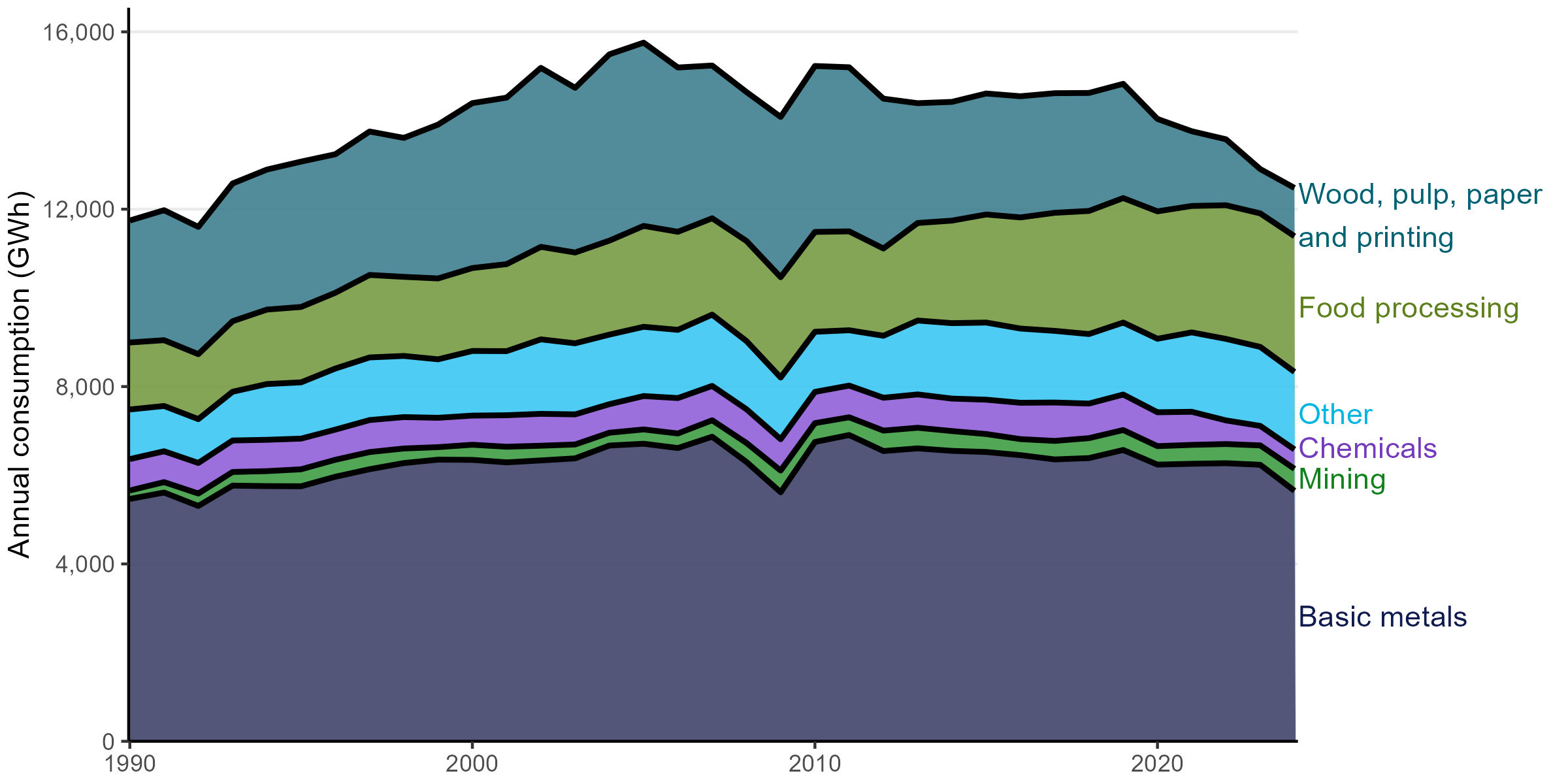Electricity
Low hydro inflows and lower gas supply saw an increase in coal use for electricity generation in 2024. At the same time, increases in wind, solar, and geothermal generation capacity helped offset the drop in hydro generation, with 85.5% of electricity generated in 2024 coming from renewable sources.
On this page I tēnei whārangi
Industrial demand for electricity decreased from 2023 levels, as New Zealand Aluminium Smelters’ demand response agreement was called on, freeing up electricity for use in other sectors. The residential and agricultural sectors saw increased demand, with national electricity consumption staying steady on 2023 levels.
Background
Most of New Zealand’s electricity generation comes from renewable sources:
- Hydroelectric generation has been a part of New Zealand’s energy system for over 100 years and continues to provide a large share of our electricity needs. At over 5,000 MW, hydro accounts for around half of national generation capacity, with most of it found in the South Island.
- Geothermal generation in New Zealand began over 55 years ago with the opening of the Wairakei Power Station in November 1958. Most of New Zealand’s installed capacity is in the Taupō Volcanic Zone. Geothermal plants run as baseload, meaning that they are unable to quickly increase or decrease their generation output.
- Wind generation has grown quickly as a source of electricity in New Zealand with the first wind farm commissioned in 1997. The largest wind farms are in the North Island.
- Solar is a relatively new source of electricity generation in New Zealand. As well as households and businesses having their own solar panels for on-site generation (‘distributed solar’), there are also large-scale (or ‘utility-scale’) solar farms feeding into New Zealand’s national grid.
In most years, over 80% of electricity is generated from renewable sources. The remainder of electricity generation comes from the combustion of non-renewable sources such as coal, oil, and natural gas. These fuels account for around a fifth of New Zealand’s annual electricity generation.
Around a third of New Zealand’s electricity is used by households and around a third is from industrial sectors. Most of our industrial electricity demand comes from the basic metals, food processing, and wood, pulp and paper processing sectors. The aluminium smelter at Tiwai Point is the largest single user of electricity in the country. The commercial sector consumes around a quarter of New Zealand’s electricity demand. The remaining demand comes from the agriculture, forestry, and fishing sectors and transport.
Low inflows see increased generation from non-renewable sources
In 2024, 43,879 gigawatt hours (GWh) of electricity was generated in New Zealand, up 0.9% from 2023. Low hydro inflows saw electricity generation from hydroelectric plants fall. This drop in generation was covered by a combination of new capacity from other renewable sources, and increased generation from non-renewable sources (natural gas, coal, and oil).
Overall, 85.5% of electricity in 2024 came from renewable sources, down from 88.1% in 2023 (Figure 5).

Figure 5. The proportion of total electricity generation from each fuel type, by year.
View chart data for figure 5
Annual hydro generation falls to lowest level since 2013
Hydro is a major of source of New Zealand’s electricity generation, with just under 60% of annual generation coming from hydroelectric plants in the past decade.
Dry conditions in May, June, and July 2024 resulted in low hydro lake levels, leading to lower hydro generation. Hydro accounted for 23,490 GWh in 2024, a 11% decrease from 2023 and the lowest level since 2013.
The first two quarters of 2024 saw similar levels of hydro generation to that observed in recent years (Figure 6). However, the dry conditions, notably in June and July 2024, saw hydro generation in the September 2024 quarter being 17% lower than the September 2023 quarter. The September 2024 quarter saw the lowest hydro generation for a September quarter since 2001.

Figure 6. Quarterly hydro generation in 2024 (teal bars), compared to 2020-2024 average hydro generation for that quarter (grey bars).
View chart data for figure 6
Record generation from geothermal, solar, and wind
While hydro generation fell in 2024, generation from other renewable sources reached new records as newly commissioned plants lead to increased capacity (Figure 7). This helped keep the share of electricity generated from renewable sources relatively high at 85.5% in 2024.
Generation from solar increased 62% to its highest level on record at 601 GWh. Driving this was a significant increase in capacity due to the commissioning of several utility-scale solar farms, including Kohirā (November 2023), Naumai (May 2024), Ruawai (December 2024), and Rangitaiki (March 2024). Collectively, these plants have added 87 megawatts (MW)[2] to New Zealand’s generation capacity.
New capacity additions in addition to windy conditions in parts of the year also saw generation from wind reach a new record, up 22% on 2023 levels at 3,919 GWh in 2024. Contributing to this was the new 176 MW2 Harapaki wind farm, which started commissioning in late 2023 and became fully operational in July 2024.
Geothermal generation hit a record 8,741 GWh in 2024, an increase of 13% on 2023 levels. Contributing to this increase was the opening of two geothermal power plants, with Tauhara coming online in May 2024 and Te Huka 3 coming online in October 2024. Together, these plants added 225 MW2 of geothermal capacity.

Figure 7. Electricity generation from geothermal, wind, and solar sources, by year.
View chart data for figure 7
Increased coal use pushes up electricity emissions
In periods of reduced generation from hydro and other renewable sources, non-renewable generation (namely coal and natural gas) are used to ensure that electricity demand can be met (Figure 8).
Reduced supply in 2024 meant that less natural gas was available for electricity generation. This saw electricity generated from gas relatively unchanged from 2023 levels, down 0.6%. As a result, electricity generation from other non-renewables sources increased in 2024 to meet demand – notably during the winter months.
Electricity generation from coal increased 118% on 2023 levels, to 2,243 GWh. This saw coal accounting for 5% of electricity generated in 2024, up from 2% in the previous year.
Generation from plants that are fuelled by oil products, such as diesel, also increased to meet demand as a range of generation sources were drawn on. Electricity generation from oil increased by 443% to 25 GWh. The majority (20 GWh) of this was generated in the September 2024 quarter, which saw the highest quarterly generation from oil since the June 2008 quarter. This increase in coal and diesel saw greenhouse gas emissions from electricity generation increase in 2024.

Figure 8. Generation from hydro, other renewable sources (wind, geothermal, solar, biogas, and wood), and non-renewable sources, by year.
View chart data for figure 8
Reduced availability of generation resources led to high wholesale electricity prices between July and early August
Wholesale electricity prices rose significantly between July and early August 2024. Contributing to this was reduced availability of generation resources and increased prices for gas-fired generation due to lower gas supply.
Falling hydro storage in mid-2024 was reflected in prices for hydro generation, which increased to reflect less available supply. When hydro generation is low, generation is often needed from thermal fuels, such as natural gas and diesel, which tend to have higher prices. To fill the gap in supply, thermal fuels increased their output, but at a higher price due to limited gas supply.
Additionally, low wind generation in early August 2024, further contributed to reduced generation and upwards pressure on wholesale electricity prices.
National electricity consumption remains steady
Electricity consumption in New Zealand in 2024 was 40,002 GWh, a 0.3% increase on 2023 consumption. Consumption in the industrial and commercial sectors decreased, down 3.3% and 1.0% respectively. Electricity consumption by the residential sector exceeded industrial demand for the second year in a row, up 1.9% on 2023 levels (Figure 9).

Figure 9. Electricity consumption by sector, by year. “Other sectors” includes transport, unallocated onsite generation, and unallocated demand.
View chart data for figure 9
Electricity use in some industrial subsectors increased due to changes in activity and fuel switching
Electricity use in the wood, pulp, and paper subsector increased 9.1% (90 GWh) from 2023 levels. Contributing to this increase was the re-opening of Pan Pac’s Whirinaki site in early 2024 which had closed in early 2023 due to damage from Cyclone Gabrielle. Despite this increase, demand by this subsector is 27% lower than 2022 levels.
Electricity used by the wood, pulp, and paper subsector has been trending down since 2016, with the closure of several processing facilities over recent years contributing to this. In August 2024, Winstone Pulp International announced a pause in operations at their Karioi pulp mill and Tangiwai sawmill, before announcing their official closure in September 2024. Oji Fibre Solutions confirmed the closure of their Penrose paper recycling mill in September 2024, with the closure taking place in December 2024.
Electricity consumption by the food processing sector has been steadily increasing since 2012 (Figure 10). Contributing to this growth has been electrification in the dairy processing sector, with processors switching from fossil fuels to electricity. In 2024, Mataura Valley Milk completed the installation of a new electric boiler leading to it becoming the first dairy factory in New Zealand to be all-electric.

Figure 10. Industrial electricity consumption by subsector, by year.
View chart data for figure 10
Total industrial demand fell due to demand-side response
Despite the increased electricity use in food processing and wood, paper, and pulp subsectors, total industrial sector demand fell due to a 9.4% reduction in electricity use in the basic metals subsector.
Electricity use in the basic metals subsector in 2024 was at its lowest level since 2009. The combination of low hydro inflows and decreased gas supply during the winter of 2024 saw Meridian Energy call on its demand response agreement with New Zealand Aluminium Smelters (NZAS). NZAS is the single largest user of electricity in the country, accounting for around 12% of the national annual electricity consumption on average over the past decade. This agreement allows Meridian Energy the option to ask NZAS to reduce its electricity consumption at their Tiwai Point aluminium smelter, freeing up electricity to meet demand elsewhere in the country.
Over July and August 2024, Meridian Energy made a series of demand response calls to NZAS, requiring them to reduce electricity usage by a total of 185 MW from early August. A further 20 MW was then negotiated over and above the existing demand response agreement. These demand response calls saw annual electricity use by NZAS fall to its lowest level since 2009, when a transformer fault at that time resulted in the closure of one of the potlines.

